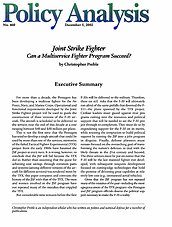For more than a decade, the Pentagon has been developing a multiuse fighter for the Air Force, Navy, and Marine Corps. Operational and functional requirements developed by the Joint Strike Fighter project will be used to guide the construction of three versions of the F‑35 aircraft. The aircraft is scheduled to be delivered to the services near the end of this decade at a cost ranging between $40 and $50 million per plane.
This is not the first time that the Pentagon has tried to develop a single aircraft that could be used by more than one of the services; memories of the failed Tactical Fighter Experimental (TFX) project from the early 1960s have haunted the JSF project at every turn. It is wrong, however, to conclude that the JSF will fail because the TFX did so. Rather than assuming that the quest for achieving cost savings through common parts and systems (among different versions of the aircraft for different services) was rendered moot by the TFX, this paper compares and contrasts the history of the JSF with that of the TFX. The men and women involved in the JSF program have not repeated many of the mistakes that crippled the TFX.
But considerable time remains before the first F‑35s will be delivered to the military. Therefore, there are still risks that the F‑35 will ultimately run afoul of the same pitfalls that doomed the F‑111–the plane spawned by the TFX project. Civilian leaders must guard against rival programs cutting into the resources and political support that will be needed to see the F‑35 project through to completion. They must do so by engendering support for the F‑35 on its merits, while resisting the temptation to build political support by turning the JSF into a jobs program in disguise. Finally, defense planners must remain focused on the overarching goal of transforming the nation’s defenses to deal with the likely threats in the 21st century and beyond. The three services must be put on notice that the F‑35 will be the last manned fighter ever developed, with subsequent weapons development focused on cutting-edge technologies that hold the promise of delivering great capability at relatively low cost (e.g., unmanned aerial vehicles).
Given that the JSF program has not repeated many of the mistakes of the past–including the most egregious errors of the TFX program–the Pentagon and JSF program officials deserve the political support necessary to make the F‑35 a reality.

This work is licensed under a Creative Commons Attribution-NonCommercial-ShareAlike 4.0 International License.

